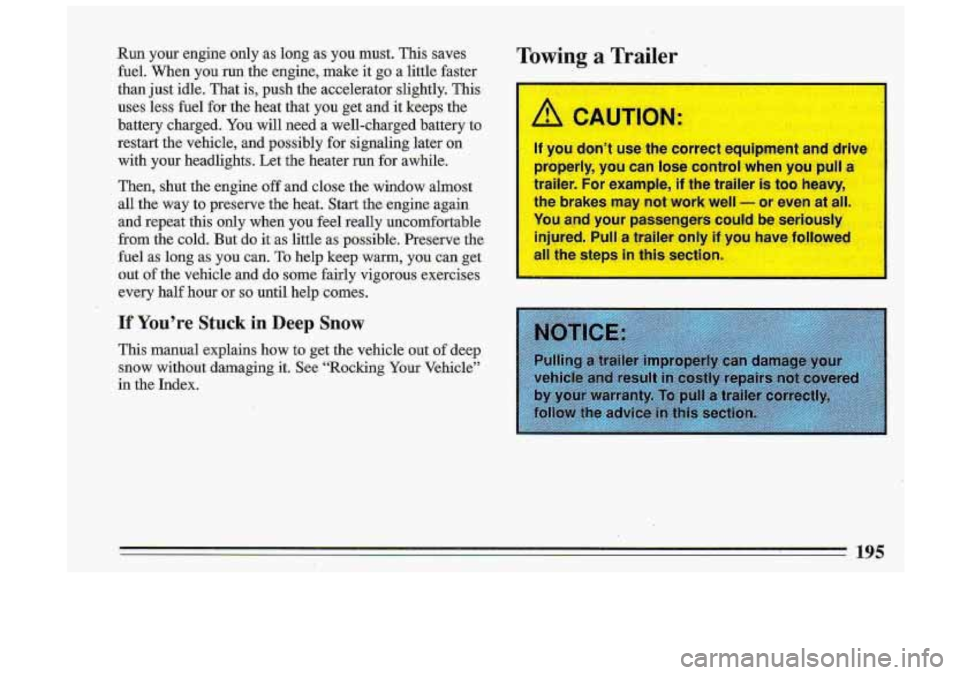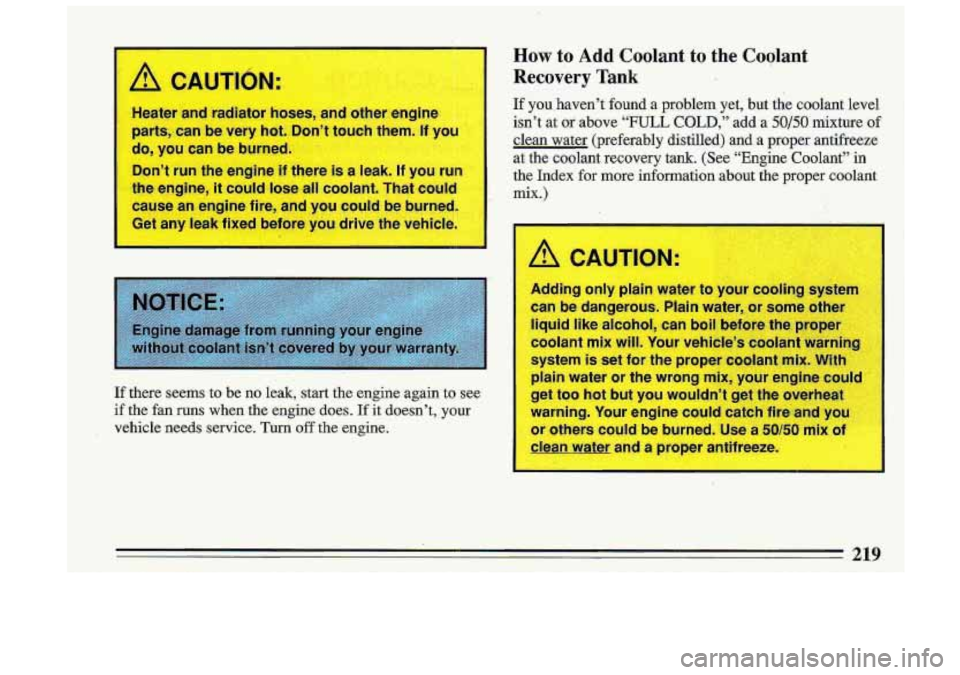Page 193 of 340
Winter Driving
Here are some tips for winter driving:
Have your Buick in good shape for winter. Be sure
your engine coolant mix is co-rrect.
Snow tires. can help in loose snow, but they may give
you less traction on ice than regular tires. If you do
not expect to be driving
in deep snow, but may have
to travel over ice,
you may not want to switch to
snow tires at all.
You may want to put winter emergency supplies in
your vehicle.
I
I
.. . ..
Include an.ice:scrapGq a small brush .or broom, a supply
of'windshield washer fluid,
a rag, some winter outer
clothing,
a small shovel, a flashlight, a, red. cloth,. and a
couple
.of reflective warning triangles. And, if you will
be driving under:severe conditions, include a small bag
of sand, a piece of ,old carpel .or a couple of burlap. bags
to help provide traction. Be sure y.ou properly secure
these items in your vehicle.
Page 196 of 340
blanket around you. If you have no blankets or extra. II
clothing, make body insulators. from newspapers, burlap I CAUTION: (Continued)
bags, rags, floor math - anything you can wrap around 3pen a window just a Iihz oh &he side of the
yourself OX tuck under your clothing to keep warm. ._ .. ,... r’ ,. . I vehicle that’s away from the wind. This will helr
Yon can run the engine to keep warm, but. be careful.
,. ,
/A CAUTION:
Snow can trap exhaust gases under your
vehicle. This can
cause deadly CO (carbnn
monoxide)
gas to get inside. CQ could
overcome you and kill you. You can’t see it o
smell it, so y~u might not know it was in you1
vehicle. Clear
away snow from around the base
of your vehicle, especially any that is blockina
your exhaust
gibe. And check around again
from time to ti P to be sure snow doesn’t
collect there.
CAUTION: (Continued)
Page 197 of 340

Run your engine only as long as you must. This saves
fuel. When you
run the engine, make it go a little faster
than just idle. That is, push the accelerator slightly. This:
uses less fuel for the heat that you get and it keeps the
battery charged.
You will need a well-charged battery to
restart the vehicle, and possibly for signaling later
on
with your headlights. Let the heater run for awhile.
Then, shut the engine
off and close the window almost
all the way to preserve the heat. Start the engine again
and repeat this only when you feel really uncomfortable
from the cold. But do
it as 'little as possible. Preserve the
fuel
as long as you can. To help keep warm, you can get
out of the vehicle and
do some fairly vigorous exercises
every half hour or
so until help comes.
Towing, a Trailer
/! CAUTION-
If you don't use the correct equipment and drive
properly, you can lose control when you
pull a
trailer.
For example, if the trailer is too heavy,
I the brakes may not work well - or even at all,
You and your passengers could be seriously'
injured. Pull
a trailer only if you have followed
I the steps in this section.
Page 205 of 340
Part 5 Problems on the Road
I- .. . 1. ’ . ’ ‘I
.. .....
Here you’ll find what to do about some problems that can occur on the road .
Part 5 includes:
Hazard Warning Flashers
............................................................
“Jump”Starting ...................................................................
OtherWarningDevices .............................................................
TowingYourBuick ................................................................
Engineoverheating ................................................................
IfaTireGoesFlat .................................................................
ChangingaFlatTire ................................................................
CompactSpareTire ................................................................
If You’re Stuck in Sand, Mud, Ice or Snow ..............................................
204
205
206
212
216
224
224
238
239
Page 209 of 340
I
I
You eou be injured ! V€ !s roll
parking brake firmly on each vehicle. Put an
automatic transmission
in ‘‘P” (Park) or a
manu nsl in 9
3. Twm off the ignition .on both vehicles. Turn ofr all
lights that aren’t needed, and radios. This will avoid
sparks- and help save both batteries. And
it could
save your radio!
4. Open the hoods and locate the batteries. Find the
positive (+) and negative (-) terminals on each
battery. Your Buick has two remote positive.
(+) jump
starting terminals.
The terminals are in the red box
on the. same side’of the engine compartment BS your
battery.You should always use one, of the remote
.positive
(+) terminals instead of the positive (+)
terminal on your battery.
To open the remote positive (+) terminal box, pull
the tab and open the cover.
Page 212 of 340
8. Now connect the black
negative
(-) cable to,
the good battery's
negative
(-) 'terminal.
9. Attach the cable at least 1.8 inches (45 cm) away
from the dead banery, .but not nm=engine parts that
move. The electrical connection
is just as go:od there,
but the chance
of sparks getting back to the battery'is
much less.
.e%' . a, , '. I ,
" ". . ,.. .
Don't let the other end touch anything until the next
step. The other
end of the negative cable doesn't go
to the deadbattery. It goes to a heavy unpainted
metal
part on the engine of the vehicle with the dead
battery.
10. Now start the vehicle with the good battery and run
the engine for awhile.
210
Page 219 of 340
1. Turn off yom air conditioner.
If :No .Steam Is Coming From Your Engine:
If you get the overheat warning but see or hear no
steam, the problem may not be
too serious. Sometimes
the engine can get a little
too hot when you:
Climb a long hill on a.hot day.
Stop :after high speed driving.
Idle for long periods in traffic.
Tow a trailer.
If you get the overheat warning with no sign of steam,
try this
for a minute or so:
If there's still no. sign of steam, push the accelerator until
the .engine speed is about twice
as fast as normal idle-
speed. Bring the engine speed back
to normal idle speed
after two or three minutes.
Now see if the warning stops.
But then,
if you still have the-warning, TURN OF'F THE
ENGINE AND GET EVERYONE OUT OF THE
VEHICLE until it cools down.
You may decide not to 1ift.the hood but to get service
help right away.
217
Page 221 of 340

1
I
11 parts, can be very hot. Don’t 1 Ich them. I
do, you can be burned.
Don’t
run the engine if ther I leak. If yo
the engine,
it could lose all coolant. That could
cause an engine Pire, and you could be burned.
Get any leak fixed before you drive the vehicle.
If there seems to be no leaK, start tne engine again to see
if the fan runs when the engine does. If it doesn’t,, your
vehicle needs service. Turn
off the engine.
How to Add Coolant to the Coolant
Recovery Tank
If you,haven’t found a problem yet, but the coolant level
isn’t at or above
“FULL COLD,” add-a 50/50 mixture of
clean water (preferably distilled) and a proper antifreeze
at the coolant recovery tank. (See “Engine Coolant’’ i\
n
the Index for more information about the proper coolant
mix.)
can be dangerous. Plain water, or some other I
liquid like alcohol, can boil before the, proper
coolant mix will. Your vehicle’s coolant warning
system
is set for the proper coolant mix. With
plain water
or the wrong mix, your engine could
get too hot but you wouldn’t get the overheat
warning. Your engine could catch fire.and you
or others could be burned. Use a 50/50 mix of
clean
---- s-- -1 a proper antifr ze.
5
219 1 i